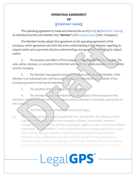What to Do When Someone Breaks Your NDA
You took the right step: you had someone sign a Non-Disclosure Agreement (NDA) to protect your confidential information. But now you’ve discovered...
7 min read
LegalGPS : May. 19, 2025
You worked hard to build your brand—your logo, your messaging, your unique voice. Then one day, you stumble across another website, Instagram account, or Etsy shop... and there it is. Your logo. Your words. Your identity. Used without permission.


Legal GPS Pro
Protect your business with our complete legal subscription service, designed by top startup attorneys.
Whether it’s a blatant copy-paste job or a slightly tweaked imitation, stolen branding and content can seriously damage your business. It confuses customers, dilutes your search rankings, and makes you look less professional—even though you're the one who got ripped off.
So what can you do about it?
This guide walks you through the exact steps to take if someone steals your logo, images, or written content. We’ll break down how to verify infringement, what tools to use, how to respond, and when to escalate. You’ll also find actionable tips and real-world examples to protect your brand moving forward.
Before you go into full panic mode or fire off a threatening email, make sure the infringement is real. Not everything that looks similar is legally considered theft.
Here’s how to check:
Let’s say you own a boutique candle company. One afternoon, a friend texts you a screenshot: a new online shop is selling candles with a logo that looks 90% like yours—same flame icon, nearly identical font, just a different color.
You run a reverse image search and confirm they’ve used your logo from an old Instagram post—just with a filter added. That’s a classic case of logo theft, and it’s worth acting on quickly.
Once you’ve confirmed someone has stolen your logo or content, don’t jump straight to confrontation. First, build a clean, organized file of evidence. This will strengthen your case—whether you’re handling it yourself, reporting the offender to a platform, or escalating to legal action.
Here’s what to collect:
Use these tools to stay ahead of future theft:
These tools don’t just help you catch infringement—they also give you the receipts to prove it.
Before you take action, it’s essential to make sure you have the legal authority to do so. Just because something is associated with your brand doesn’t always mean you own the enforceable rights—especially if a third party created it for you or you haven’t registered it.
If your logo is registered with the USPTO (U.S. Patent and Trademark Office), you have a strong legal foundation to stop others from using it. But even without registration, you may still have common law rights if you've been using the logo consistently in commerce.
Here’s the breakdown:

Cease and Desist Letter
Learn how to write a cease and desist letter to protect your rights and halt infringement or harassment effectively.
Trusted by 1,000+ businesses to safeguard their LLCs.
Copyright protects original content automatically the moment it’s created, whether it’s blog posts, website copy, product descriptions, or photographs.
You don’t need to register with the U.S. Copyright Office to have rights, but:
Also important: if someone else designed your logo or wrote your content (e.g., freelancer, agency), do you own the rights? Make sure you have a work-for-hire agreement or a clear IP assignment clause in place. Otherwise, you may not have full enforcement authority.
If you're confident that your rights were violated and you own the intellectual property, your next step is direct communication.
Start with a professional, non-aggressive message. Sometimes, people genuinely don’t realize they’re infringing.
If you don’t get a response or the issue is severe, the next step is a formal cease and desist letter—preferably from an attorney.


Legal GPS Pro
Protect your business with our complete legal subscription service, designed by top startup attorneys.
If the infringer is using your logo or content on a major platform—like Etsy, Instagram, Facebook, Shopify, or Amazon—you can often skip the back-and-forth and file a direct intellectual property complaint. Many platforms have built-in systems to quickly remove infringing material.
A small business owner noticed that another account was reposting their product photos and passing them off as original. The business owner submitted a copyright complaint to Instagram with proof of original ownership. Within 24 hours, the copied posts were removed and the infringer’s account received a warning. No lawyer needed—just proper documentation and a clear request.
If platform reports don’t work—or if the infringement is substantial, ongoing, or damaging to your business—it's time to consider legal escalation.
Legal action can be costly, so weigh the potential financial or reputational harm against the effort. In many cases, a formal letter from a lawyer will get results without ever stepping foot in court.
If someone is using your logo or writing to mislead customers—especially in a way that results in sales or harm to your reputation—you may be entitled to compensation for lost business. An experienced attorney can help you not only stop the infringement but also pursue damages.
While you can’t stop every bad actor from copying your brand assets, you can make it significantly harder—and easier to enforce your rights when it happens again.
A registered trademark is your strongest weapon against logo theft. It gives you:
If your logo is central to your brand identity, registration is a smart long-term investment.
For content like blog posts, product photos, and custom designs:
This won’t stop determined infringers, but it sets clear expectations—and strengthens your legal claims.
Set up alerts and automate content monitoring:
Create a ready-to-go enforcement kit that includes:
Having these ready can cut your response time in half when an issue pops up.
Discovering someone has stolen your logo or content is frustrating—but it’s also a moment to take control of your brand’s protection. Whether you’re dealing with a careless copycat or an intentional impersonator, you’ve got options.
Start by verifying the infringement, gathering evidence, and contacting the offender. Use platform tools to report violations, and don’t hesitate to escalate with legal help if the damage is real. Then take steps to lock down your brand so future problems are easier to solve—or prevent altogether.
The biggest question now is, "Do you need a lawyer for your business?” For most businesses and in most cases, you don't need a lawyer to start your business. Instead, many business owners rely on Legal GPS Pro to help with legal issues.
Legal GPS Pro is your All-In-One Legal Toolkit for Businesses. Developed by top startup attorneys, Pro gives you access to 100+ expertly crafted templates including operating agreements, NDAs, and service agreements, and an interactive platform. All designed to protect your company and set it up for lasting success.

Legal GPS Pro
Protect your business with our complete legal subscription service, designed by top startup attorneys.
|
Premium Template
Single-use Template |
Legal GPS Pro
Unlimited Access, Best Value |
|
|
| Choose Template | Learn More |
| Trusted by 1000+ businesses | |
Table of Contents

You took the right step: you had someone sign a Non-Disclosure Agreement (NDA) to protect your confidential information. But now you’ve discovered...

That moment when you open your mail or email to find a formal letter from an attorney threatening legal action can stop your heart for a moment. A...

You’ve poured your heart into creating a unique brand name, logo, or slogan for your business. Then, you discover a competitor using a similar name,...